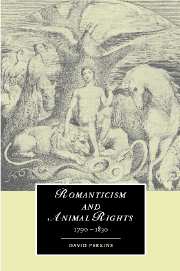Book contents
- Frontmatter
- Contents
- Preface
- Acknowledgments
- 1 In the beginning of animal rights
- 2 Grounds of argument
- 3 Keeping pets: William Cowper and his hares
- 4 Barbarian pleasures: against hunting
- 5 Savage amusements of the poor: John Clare's badger sonnets
- 6 Work animals, slaves, servants: Coleridge's young ass
- 7 The slaughterhouse and the kitchen: Charles Lamb's “Dissertation upon Roast Pig”
- 8 Caged birds and wild
- Notes
- Bibliographical essay
- Index
- CAMBRIDGE STUDIES IN ROMANTICISM
7 - The slaughterhouse and the kitchen: Charles Lamb's “Dissertation upon Roast Pig”
Published online by Cambridge University Press: 22 September 2009
- Frontmatter
- Contents
- Preface
- Acknowledgments
- 1 In the beginning of animal rights
- 2 Grounds of argument
- 3 Keeping pets: William Cowper and his hares
- 4 Barbarian pleasures: against hunting
- 5 Savage amusements of the poor: John Clare's badger sonnets
- 6 Work animals, slaves, servants: Coleridge's young ass
- 7 The slaughterhouse and the kitchen: Charles Lamb's “Dissertation upon Roast Pig”
- 8 Caged birds and wild
- Notes
- Bibliographical essay
- Index
- CAMBRIDGE STUDIES IN ROMANTICISM
Summary
To eat an animal can be seen as an ultimate exploitation. It was and is a cause of bad conscience in many persons. But few animal sympathizers were vegetarians, though we shall hear from them, and enormous economic interests were involved. Most pleaders on behalf of animals neither hoped nor wished to abolish the eating of meat, but sought to reform processes by which animals were reared, brought to market, fattened, and slaughtered. There was much they could deplore. Sheep, cattle, turkeys, and geese were driven from far to feed the city of London. Cattle came from Scotland, 500 miles away, and even from the Hebrides; sheep from Lincoln, Norfolk, Somerset, and Devon; turkey and geese walked as much as eighty miles, their feet in little cloth shoes. Perhaps a million animals were driven to London each year. The same thing happened on a smaller scale with provincial cities. For the animals, these were journeys of woe. They arrived emaciated. Once they were fattened outside London, they were driven to sale in Smithfield market and then to the slaughterhouses. Hogarth's “Stages of Cruelty” shows sheep being beaten through the city streets, an ordinary sight. John Lawrence describes all this. He also tells how in London calves on their way to slaughter were piled on wagons in living pyramids of confused bodies. Once arrived at Smithfield, they were thrown from the wagons to the cobblestones. A crowd commonly gathered to watch, for bones might be broken in the fall.
- Type
- Chapter
- Information
- Romanticism and Animal Rights , pp. 116 - 129Publisher: Cambridge University PressPrint publication year: 2003

